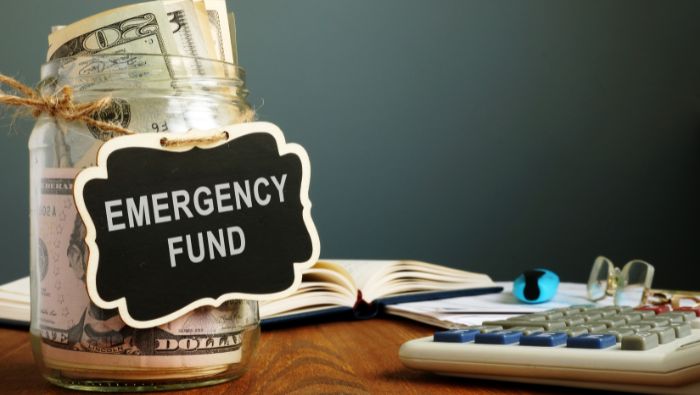A Good Reason To Put Your Emergency Fund Into CDs
by Andrea Norris-McKnight

Most financial experts agree that CDs aren’t ideal for emergency savings. However, there is one good reason to consider putting your emergency fund into CDs that may actually help you save.
Does building an emergency fund feel like two steps forward and one step back for you, even though you rarely experience a financial emergency? If you often find yourself dipping into your emergency fund for non-emergencies, you might find this tip from one of our readers helpful:
My husband and I are working toward saving money for an emergency fund. To make sure we don’t spend this money on anything but an emergency, we put it into CDs, and we vow not to spend it unless my husband loses his job. Once it is in a CD, it takes more effort to get our money out than when using a regular savings account, and it takes a lot of talking between us before we consent to cash in a CD.
CDs are not hard to get your money out of early, although you typically will have a penalty for early withdrawal (something we have only done twice in the last five years), which makes us really consider whether we’re truly facing an emergency or not. If it is a real emergency, you will be willing to forfeit the small penalty. If not, it isn’t an emergency.
Every time we save another $1,000 for our emergency fund, we open another CD. The goal is to have a CD coming due every month. In the event of a real emergency, i.e., my husband loses his job, we will have another CD available for use every month.
We feel investing in CDs with our emergency fund helps us better protect our emergency savings from ourselves.
P.H.
This strategy won’t necessarily make you the most money on your savings, but it may help you save the most money. Let’s break down how this strategy works and examine some pros and cons of using CDs for emergency savings.
A Few Cons and One Big Pro to Putting Your Emergency Fund Into CDs
Our reader solved a common emergency fund problem — how to protect your savings from yourself. Most financial experts recommend a high-yield savings account rather than CDs for emergency savings, but why?
Fixed Interest Rates and Early Withdrawal Penalties
Choosing between a savings account or CDs can depend on the direction interest rates are heading. Traditional CDs have a fixed interest rate. That fixed rate is great if interest rates are dropping, but when interest rates are on the rise, an account with a variable rate (a savings account) is a better option. However, interest rates are expected to drop in 2024, so now may actually be a good time to put money into CDs.
Another disadvantage of CDs is the early withdrawal penalty common with traditional CDs. As you may know, you deposit your money into a CD for a specified period. You typically pay a penalty if you withdraw your funds before the CD maturity date. The penalty is usually a set number of months’ worth of interest and will vary based on the financial institution and the length of the CD. The only time you may lose any of your initial deposit for early withdrawal is if you have not yet earned enough interest to cover the penalty, but you can potentially lose a significant amount of your earned interest.
One Good Reason To Use CDs for Emergency Savings
For some folks, how much you save is more important than how much you earn on that savings. If, like the reader above, you tend to dip into your savings for too many non-emergencies, CDs might be the better choice for an emergency fund. You know your “spending” personality best.
If you do choose CDs, you may want to consider building a CD ladder rather than putting your entire emergency fund into one CD to keep your money as liquid as possible. A CD ladder is a savings strategy in which you buy multiple CDs with different maturity dates. That way, you have regular access to some of your money.
Sign Up for Savings
Subscribe to get money-saving content by email that can help you stretch your dollars further.
Twice each week, you'll receive articles and tips that can help you free up and keep more of your hard-earned money, even on the tightest of budgets.
We respect your privacy. Unsubscribe at any time.
How Does a CD Ladder Strategy Work?
You’ll start by dividing your emergency fund between multiple CDs. You can get several with different terms, such as 6, 9 and 12 months. Or you can buy one CD this month, say a 3-month CD, and then buy another 3-month CD next month. The number of CDs and their terms are up to you. Just make sure they mature at different times. If you are still building your emergency savings, each time you save a specific amount, whatever you decide, use the money to get another CD with a different maturity date.
The tip above refers to buying CDS in $1,000 increments and having a $1,000 CD come due every month. Some financial institutions have minimum deposit requirements, often $1,000, to get a CD. However, you can find several banks that allow you to get a CD in any amount. Capital One and Synchrony are two banks that don’t have minimum CD deposit requirements.
When a CD matures, unless you need the money for an emergency, you roll it into another CD set to mature at a date later than your longest-term CD or during a month that you don’t yet have a CD maturing.
Savings Account or CDs: Where Will You Put Your Emergency Fund?
Right now, you can earn a decent return on your emergency savings whether you choose CDs or a high-yield savings account. So, choosing the best option may depend more on your spending and saving habits than on how much money you can earn.
If you aren’t prone to dipping into savings any time you need a little extra cash, a high-yield savings account is probably the better choice for your emergency fund. You can access your money as needed without penalty. However, if you need to protect your savings from yourself, consider setting up a CD ladder.
Get More Help Building an Emergency Fund
Wouldn’t it be nice if deciding where to put your emergency fund was the biggest savings challenge you faced? For most of us, building an emergency fund is the hard part.
The following articles can help you build your emergency savings and know when and when not to use your funds:
Reviewed February 2024
Sign Up for Savings
Subscribe to get money-saving content by email that can help you stretch your dollars further.
Twice each week, you'll receive articles and tips that can help you free up and keep more of your hard-earned money, even on the tightest of budgets.
We respect your privacy. Unsubscribe at any time.
Popular Articles
- 7 Habits of Highly Frugal People
- 5 Simple Budget Cuts That Can Save $200 a Month
- How to Track Down Unclaimed Funds Owed You
- 32 Ways to Save Money on Your Utility Bills
- Do You Need Credit Life Insurance When Buying a New Car?
- How to Maximize Profits When Selling Online
- Staying Motivated to Continue Digging Yourself Out of Debt
On After50Finances.com
- 9 Things You Need to Do Before You Retire
- You Didn’t Save Enough for Retirement and You’re 55+
- When Empty Nesters Reorganize and Declutter Their Home
- Reinventing Your Career in Your 50s or 60s
- What Mature Homeowners Should Know about Reverse Mortgages
- 2 Reasons to Collect Social Security Benefits As Soon As Possible

